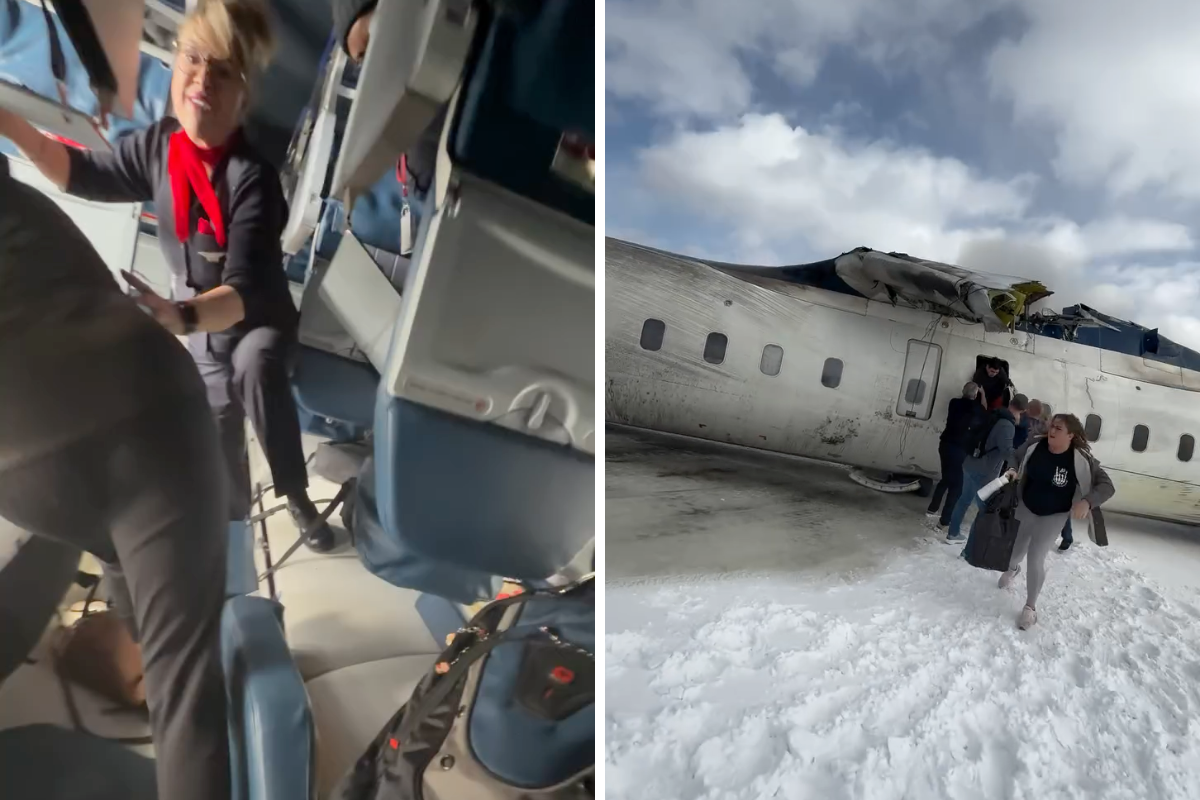
In the wake of the horrific crash of Delta Air Lines flight DL4819 on Monday afternoon at Toronto Pearson International Airport (YYZ), there has been a lot of discourse on social media about the actions of the flight crew in getting all 76 passengers safely off the badly damaged upside down regional jet.
For the union that represents flight attendants at Endeavour Air, the wholly-owned subsidiary of Delta that operated the flight, the crew members represented the very best of their profession, but that hasn’t stopped uneducated online commentators disparaging their heroic efforts.
One of the main causes of angst amongst the keyboard crash investigators that have swarmed the internet with their opinions on the evacuation was the fact that passengers were reportedly instructed by flight attendants to ‘hang like bats’ upside down in their seats while the plane burned.
In fact, there are even some reports that flight attendants continued to yell at passengers to remain strapped into their seats until their hands were finally forced as passengers unbuckled their lap belts and started to self-evacuate.
The truth, however, is that in the immediate aftermath of a crash, telling passengers to remain seated with their seatbelts securely fastened is very much standard protocol for flight attendants around the world, and it’s for a very good reason.
In those first few seconds, it’s important that flight crew build their situational awareness of what is happening around them. What happened on Flight 4819 is a very extreme example of how a seemingly routine landing can literally turn upside down in a split second.
In the following seconds, the flight attendants must survey the environment and identify the hazards around them, before deciding whether it necessary and safe to conduct an emergency evacuation.
Is there a fire outside? If so, on what side of the aircraft and does that mean certain exits can’t be used to evacuate passengers? Are there any other hazards at any of the emergency exits? Are the aircraft engines still running? Do the pilots have additional information to share? Does the airport fire service have vital information to share that will be communicated via the pilots?
If an evacuation is necessary, which passengers will need additional assistance? Which passengers could be used as so-called ‘abled-bodied passengers’ to assist flight attendants in the evacuation? What emergency onboard equipment could be used? Where is it located?
These are all critical questions that need to be quickly considered as flight attendants open up communication with one another and the pilots before an evacuation can safely get underway.
As an example, consider the fire that engulfed a Japan Airlines Airbus A350 after it crashed into a small coastguard aircraft as it landed at Tokyo Haneda Airport in January 2024.
In that incident, flames licked at the windows of the aircraft as passengers followed instructions to remain seated as flight attendants assessed the outside conditions and determined what exits were usable before ordering an evacuation.
Then there are the commands that the flight attendants could be heard shouting at passengers as they evacuated passengers from the crashed CRJ regional jet at Toronto Pearson.
Cockpit commentators have somehow created conspiracy theories out of the fact that the flight attendants yelled at passengers to put their mobile phones away and stop filming, bizarrely suggesting that, at that very moment, the flight attendants were solely concerned about minimizing media coverage of the incident.
The truth is just so much more boring. While the eyewitness, first-person videos of the video are fascinating to watch, the primary concern of flight attendants is making sure the evacuation happens in as little time as possible.
Passengers slowing down the evacuation by videoing the whole ordeal is something they are desperate to avoid. Typically, flight attendants have set evacuation commands and phrases, but dynamically going off script to address anything that could be slowing down the evacuation should not be a cause for criticism.
Matt’s take
It’s totally understandable why passengers involved in a serious plane crash would want to get off a burning jet as quickly as possible, and while we can’t account for what people might do in the heat of the moment, it’s important to understand how evacuation processes work in the way that they do.
That means that passengers might be asked to do, essentially, nothing when their ‘fight or flight’ response is telling them to do exactly the opposite. This delay is, however, baked into the emergency response and evacuation process and could, in fact, help save lives.
Related
Mateusz Maszczynski honed his skills as an international flight attendant at the most prominent airline in the Middle East and has been flying ever since... most recently for a well known European airline. Matt is passionate about the aviation industry and has become an expert in passenger experience and human-centric stories. Always keeping an ear close to the ground, Matt's industry insights, analysis and news coverage is frequently relied upon by some of the biggest names in journalism.







 (@eggxit)
(@eggxit)
Also, in a situation where slides might be used, passengers rushing the door may delay or even prevent the door being opened. Telling passengers to remain seated gives the FAs a couple of seconds to get their door opened and slide deployed.